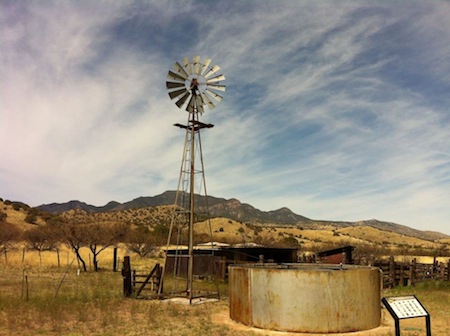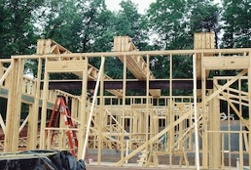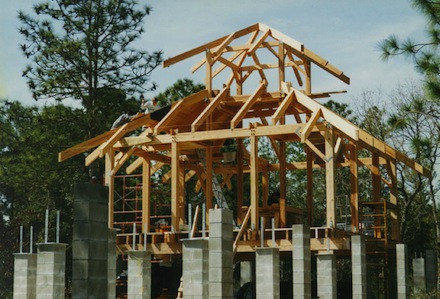Throwing the Building Science Learning Curve for a Loop

I just returned from Arizona, where I spoke at the Structural Insulated Panel Association’s annual conference. Since it was in Tucson, I also took the opportunity to visit with my friend David Butler. He’s an amazing source of knowledge in the field of building science, especially concerning mechanical systems, and our conversation got me to thinking about learning curves. His story is quite interesting and not so different from mine in some ways. Perhaps the advice at the end of this article, based on what David and I went through (independently) over a decade ago, will help you as you embark on your own building science learning curve.
I just returned from Arizona, where I spoke at the Structural Insulated Panel Association’s annual conference. Since it was in Tucson, I also took the opportunity to visit with my friend David Butler. He’s an amazing source of knowledge in the field of building science, especially concerning mechanical systems, and our conversation got me to thinking about learning curves. His story is quite interesting and not so different from mine in some ways. Perhaps the advice at the end of this article, based on what David and I went through (independently) over a decade ago, will help you as you embark on your own building science learning curve.
David Butler’s learning curve
We were talking at breakfast yesterday morning when he told me about the information-gathering process he went through when he designed his previous home in Charlotte. He didn’t know much about building enclosures at the time. His background was electrical engineering, and his career1 until that point had been focused on developing home automation systems.
As he set about learning what he needed to know to build the house, he found varying opinions, naturally. One way he handled that was to keep digging until he found several knowledgeable people who pretty much agreed on whatever subject he was researching. He figured that when he found consensus among experts, he couldn’t go too far wrong by following their advice.
 While working through the details of his stucco wall system, however, he ran into a dilemma where no consensus emerged. That was when lawsuits were killing the synthetic stucco industry due to moisture getting trapped in the wall. David found little agreement among builders and stucco contractors on how to avoid the failures that were making the news. So he decided to seek out the leading expert on the stucco failures and trust his advice. That person turned out to be Dr. Joseph Lstiburek.2 He ended up hiring Joe to design the wall system as well as the rest of his building enclosure.
While working through the details of his stucco wall system, however, he ran into a dilemma where no consensus emerged. That was when lawsuits were killing the synthetic stucco industry due to moisture getting trapped in the wall. David found little agreement among builders and stucco contractors on how to avoid the failures that were making the news. So he decided to seek out the leading expert on the stucco failures and trust his advice. That person turned out to be Dr. Joseph Lstiburek.2 He ended up hiring Joe to design the wall system as well as the rest of his building enclosure.
He had a similar experience when he went to work for Enalasys, the company that started him down the path of becoming an HVAC expert. Enalasys was developing diagnostic tools for mechanical contractors. David was hired to help develop an HVAC monitoring system. At that point, the bulk of his knowledge about heating and cooling systems was from a controls perspective.
During his tenure at Enalasys, David joined ASHRAE and immersed himself in all things HVAC. When he had questions, he wasn’t shy about getting in touch with industry gurus and picking their brains. These two experiences are what led David to become the HVAC expert he is today.
How I found good information when I built a green home
In 2001, I was a new landowner getting ready to build a house. I knew I wanted it to be a green home, and I’d watched (and helped a tiny bit) as my grad school thesis adviser, Liz Seiberling,3 designed and built an off-the-grid green home in Florida. I had a little bit of knowledge already because of that experience. (That’s me on the roof below helping to install the tongue-and-groove roof deck circa 1996.)
I also was in the Atlanta area and was well aware of the Southface Energy Institute, so that was another great resource at my disposal. In fact, one of the first things I did was to sign up for their four-day homebuilding school. It was there that I decided to go with structural insulated panels (SIPs) as our construction method. I also made contacts there, on both sides of the desk, that helped me during the two-year process of building.
Another thing I did was to start buying copies of Fine Homebuilding magazine off the shelf when I visited Home Depot. When I started looking forward to the new issue appearing on the shelves, I knew it was time to subscribe, so I did. That was a tremendous resource. Not only did it (and still does) have information-packed, in-depth articles from pros, the section with tips also was helpful.
I was on a mission—a learning mission—and I was obsessed. I had to learn about framing, SIPs, greywater systems, composting toilets, permitting, dealing with subcontractors, putting together a cost estimate, windows, foundations, solar-powered wells, and much more.
 Of course, where it got real was when I took all that information I got from books, magazines, Southface, and experts and started talking to local trade contractors. I remember putting together the list of spec’s I wanted for my poured concrete foundation to one contractor, Wendell, and when I went to him a few days later to see if he had a bid for me, he said, “Where’d you get these spec’s? I can’t meet them.” He didn’t even want to bid on it, and he was the best foundation contractor in the area!
Of course, where it got real was when I took all that information I got from books, magazines, Southface, and experts and started talking to local trade contractors. I remember putting together the list of spec’s I wanted for my poured concrete foundation to one contractor, Wendell, and when I went to him a few days later to see if he had a bid for me, he said, “Where’d you get these spec’s? I can’t meet them.” He didn’t even want to bid on it, and he was the best foundation contractor in the area!
I learned that sometimes I had to settle for less than perfect because I just couldn’t take on every part of the job. Overall, though, I was able to incorporate a lot of the good stuff and do things the right way. Yeah, I made some mistakes but it was still a great house. In fact, it was the greenest, most comfortable, efficient home I’ve ever lived in. My next one will be even better.
How you can find good green building information
So, what does all this mean for you as you try to build your green home or fix your existing home? To summarize David’s and my experience, and add a bit more:
- Find sources that you trust.
- Keep digging.
- Talk to the local pros.
- Take advantage of blogs and Internet discussion forums.
- Think long and hard about doing it yourself.
Those points are mostly related. The better you are at gathering information, figuring out what’s valid, and avoiding information pitfalls, the better you’ll do at building or fixing your home.
Let me now offer two words of caution: First, just because someone holds a strong opinion doesn’t mean they’re right. That’s why it’s important to look for consensus.
Second, know your limits. I’ve heard horror stories about people with no experience trying to build their own home or hiring the wrong people to do something unconventional. It always ends up costing more, not less, when you bite off more than you can chew in this arena. The higher cost of a good pro looks pretty good in hindsight in those cases.
I heard recently about someone who had to go looking for a pro who could salvage something from the huge house he’d started building. A lot of the people he approached told him he just needed to tear it down and start over but he did finally find someone who could help. He’s spending a lot more money to do it right the second time than he would have if he’d started out doing it right. Don’t be that person.
Interested in ramping up your building science learning curve?
Related Articles
Working with Non-Green Trade Contractors in Building a Green Home
GUEST POST: Lessons Learned by a Reluctant Owner-Builder (by David Butler)
Footnotes
1. I also learned from him that through the mid-nineties, he had a nice business as a syndicated newspaper columnist. Maybe you saw his column, which ran in 50 papers duing the period 1992 to 1997. It was called At Home with Technology and covered all kinds of interesting topics. At the end of each article, he offered more information on the topic if the reader sent him a dollar, which so many people did that he had to hire people to handle opening and replying to the requests.
2. Joe wrote a wonderful article last November about his own building science learning curve. Aided by giants in the field of building science and the engineering ingenuity of his father, he figured out how to do Exterior Insulation and Finish Systems (EIFS) without having moisture problems.
3. Liz was the only woman on the University of Florida physics department faculty when I started there. She called her home the Solar Cracker because it was a Florida cracker-style house powered by photovoltaics. She and her husband, Randy, also bought a sawmill and sawed all the lumber for the home. If you look closely at the photos on the page about her home, you can see me swinging a hammer on the roof as we put the tongue-and-groove roof deck on. Liz and her husband Randy now live in rural Tennessee, where they’ve built another house. You can read about it in her blog, An Edible Forest Garden in Tennessee.
Photo of David Butler’s home under construction from David Butler. Photo of Liz Seiberling’s Solar Cracker home under construction from Liz Seiberling.
This Post Has 6 Comments
Comments are closed.



Those of us who hang out with
Those of us who hang out with David on his LinkedIn site are all most grateful to him.
I’m on a similar path –
I’m on a similar path – Several years ago I resigned a 22 year stint as an industrial automation engineer with Siemens and switched into high-end home HVAC and deep energy retrofits.
This came about in large part because the guy who built our custom home had great difficulty finding subs who really understand HVAC, energy conservation and building science.
Local HVAC companies simply refused to bid his work, flat out denying that a Florida home could really operate at 1200-1500 SF per ton.
We prefer ICF, but I can certainly see the appeal of SIPs. Both systems lead to much tighter homes and better integrate the insulation so as to deliver higher assembly R-values, often confused with cavity R-Values
I agree with all of the above – be on the leading but not bleeding edge. Question every local assumption. Read and participate in fora and blogs, but learn to separate the wheat from the chaff.
Be especially aware of regional climate differences – what works in Florida may not be a good fit for Massachusetts, and conversely.
Beware energy and building advice from “one-trick ponies” AKA vendors of one particular product or service. That’s like seeking retirement investment advice from a whole life insurance policy salesman…the answer is predetermined.
The folks in the energy conservation / demand management, home energy audit / efficiency rebate departments of local energy utilities can be great sources of information and networking. Likewise, they value contractors who “get it” and should be able to help in a hundred little ways.
Allison, thank you for taking
Allison, thank you for taking the time to drive down to Sierra Vista. Nice photo of the windmill at Brown Canyon Ranch. Hope you make it back so we can hike the Brown Canyon trail and experience more of Tommy’s story telling 🙂
Curt, excellent post.
Curt, excellent post. Especially the part about contractors refusing to believe that anything except 500sqft per ton is going to work regardless of how well insulated the house is. Co-workers of mine looked at me like I was nuts putting a 2 ton unit in a 1600sqft house. Even after they saw it work, they still won’t move off the 500sqft per ton thinking…
Good story as always, Allison
Good story as always, Allison. Is that you gripping the framing or standing on the wall plate?
I dove down the energy efficientcy road in 2004.
I had been building 24 years at that point and wanted to know why with all the so called experts involved, the houses just did not perform.
I found the problem is with the experts. They might be an expert in one of the 16 common divisions of construction, but had no clue how their division fit into the system.
System? What the hell are you talking about? W’re building a house, not a system!
I am now a System Based Energy General Contractor. I get it. I have not gotten it as I seem to learn something else everyday.
It is a journey that every builder and subcontractor should embark.
We have a very nice project on the beach in Hilton Head Island at the moment.
It is a 5 bedroom 4,000+ square feet house with 51 exterior doors and windows and 8 feet off the ground on wood pilings.
The house had a 4 ton and two 2 ton heat pump systems.
After the renovation there will be two 2 ton communicating systems and a very cool passive ventilation system.
We went with two systems as the great room with clerestory and the parking areas under the house made it very difficult to do a single duct system, or we would have done a single 2 ton system.
Too bad the systems start at 2 tons.
Thanks,
Gene
Learning curve. Indicates at
Learning curve. Indicates at some point the learning slows and you start to know stuff. Sounds rewarding.
Can someone hip me to when that starts to happen?